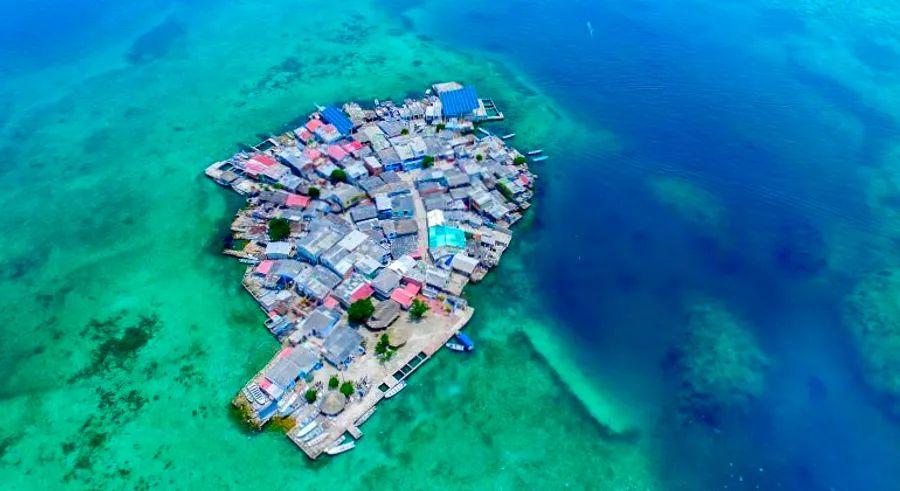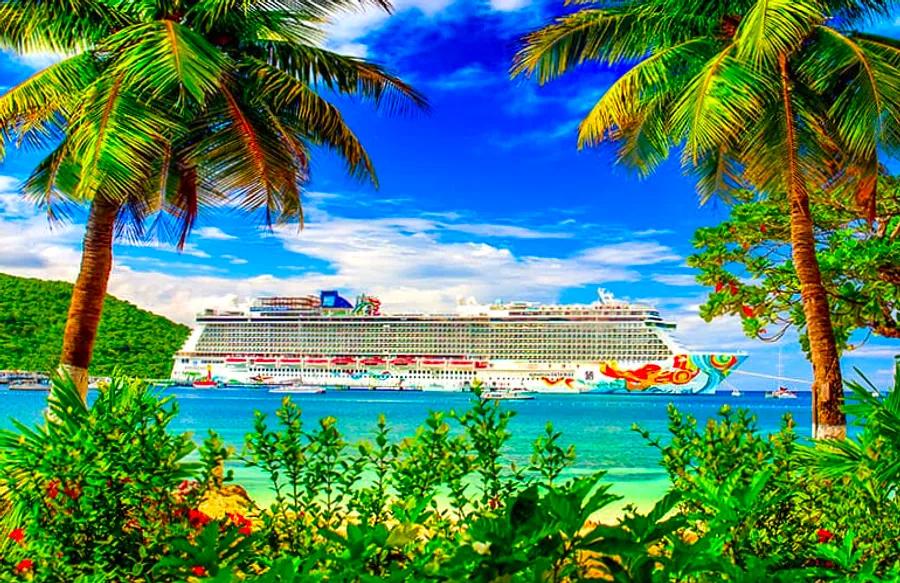This densely populated Colombian island maintains a peaceful lifestyle despite its crowded conditions.

From afar, it’s difficult to tell exactly what Santa Cruz del Islote is. Rising above the water, this island – one of the world’s most densely inhabited – appears to float effortlessly.
Santa Cruz, located in Colombia’s San Bernardo Archipelago in the Gulf of Morrosquillo, is perched on a blend of raised sea bed and coral. It is one of the ten islands in the archipelago.
Local legend says that fishermen from nearby islands first stopped at Santa Cruz to spend the night, only to decide to settle permanently after discovering the island was free of mosquitoes. The locals believe the absence of mangroves and beaches accounts for the mosquito-free environment.
Santa Cruz isn’t a typical island getaway. There are no accommodations for tourists on the island itself. Visitors usually stay at the Punta Faro hotel on Múcura Island and take a speedboat to Santa Cruz for a few hours of exploration.
Stepping onto Santa Cruz feels like entering a world from a Gabriel García Márquez novel. The island boasts a simple, almost dreamlike existence (there are no police here), and its vibrant homes, passed down through generations, ensure that no outsiders call it home.
Some estimates suggest around 1,200 people live on the small island, roughly the size of two soccer fields. However, some locals believe the population is smaller than that.
Juve Nal, a man in his sixties who has spent his entire life on Santa Cruz, puts the number closer to 900.
“We get frustrated when the media exaggerate the island’s population,” says Nal, who seems to serve as the island’s unofficial leader, guide, and spokesperson all at once.
Tight Living Conditions
Regardless of the actual population (which remains a mystery, as no census has been taken in decades), space on Santa Cruz is limited.
Around 115 houses are packed tightly together, while elderly men with gentle eyes and weathered faces relax on chairs, sipping beer. Teenage boys drift through the streets, nodding and swaying to the rhythms of champeta music, while young mothers chat at corner shops.
Nal weaves through the narrow alleys, ducking under laundry lines and pointing out the island's amenities—a church here, a school there—while he passionately describes the peaceful, laid-back lifestyle.
“There’s no crime here,” he says with a proud smile. “We have no police, and we don’t need them.”
He pauses at a small square marked by a large white cross. “This is a perfect spot for a photo,” he says, “as the cross is what gives the island its name.”

A recent collaboration with Hotel Punta Faro has led to the creation of a small conservation aquarium on Santa Cruz, helping preserve local marine life.
In the past, locals treated turtles as they would any other livestock, killing them for meat. Today, they carefully free any turtles caught in their fishing nets and tend to them until the hotel’s conservation team arrives to collect them.
Visitors can pay a nominal fee to tour the aquarium, which is home to small sharks, stingrays, and a variety of fish species.
Space on Santa Cruz is scarce, and as a result, the islanders have begun building upwards since there’s no room left to expand horizontally.
“It’s a concern for the future,” Nal acknowledges. “We’re running out of space, and I’m not sure what the solution is. We can’t keep building higher and higher.”
But the people of Santa Cruz aren’t seeking sympathy.
“We’re content,” Nal says with pride. “Where else can you live without police, where else can you have an entire island just for your own community?”
“Every morning, I wake up to the sound and sight of the sea. I wouldn’t want to live anywhere else,” Nal adds with a smile.
Visiting Santa Cruz
“It was quite disrespectful,” he says. “Now we charge a fee and offer a tour, so tourists understand that we’re not just here to be observed, but that they can learn about our culture.”
The proceeds from the tours help fund conservation projects and support the island’s daily needs, like purchasing drinking water, which is delivered by boat from the mainland every few weeks.
There are growing fears that rising sea levels will eventually claim the island. Alejandro Alzate, general manager and co-owner of Punta Faro, warns that Santa Cruz regularly faces flooding and could one day be swallowed by the rising waters.
“The locals don’t want to acknowledge this,” he sighs. “They refuse to face the reality that it means they’ll eventually have to move. Life on Santa Cruz is something you won’t find anywhere else.”
“The people take great pride in living here. It’s not just a place to live, it’s a culture, a lifestyle. They wouldn’t want to be anywhere else,”
Life on the island may seem precarious, but it’s a beautifully chaotic system, and for the islanders, it works perfectly.

1

2

3

4

5
Evaluation :
5/5